By Stephen Dark
Posted 12/06/2007
Eloy Romero sits in a booth in the Midvale Mining Café, blinking back tears of bitter 40-year-old memories. “The No. 1 motivation was to survive,” the Vietnam War Marine veteran says. “I’d do anything, anything to survive.”
His thoughts drift to his cousin, Jimmy Martinez, and another tear wells. Jimmy did not survive Vietnam. In a span of 16 dark days in late 1967, Martinez and two of his boyhood friends, LeRoy Tafoya and Tom Gonzales, died in the steamy jungles and paddy fields of Southeast Asia. The three friends had family roots in the mining camps of Bingham Canyon. Their strong Hispanic heritage celebrated patriotism. As teenagers they lived in Midvale. Two enlisted, one was drafted. Each, age 20 or younger, died in ground combat in Vietnam.
“The Hispanic people I knew all wanted to serve,” Romero says. “It was something you did.”
LeRoy Tafoya was killed on Wednesday, Nov. 22, the fourth anniversary of John F. Kennedy’s assassination. Jimmy Martinez died less than 24 hours later on Thanksgiving Day. Tom Gonzales was shot dead assaulting the enemy on Dec. 7, Pearl Harbor Remembrance Day. Three hallmark all-American days. Three more names to be placed on the The Wall—the Vietnam Veterans Memorial in Washington, D.C.
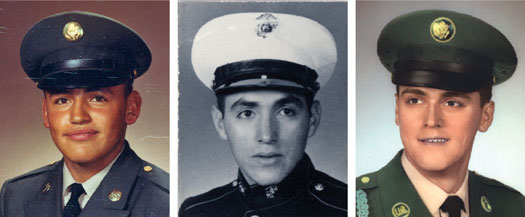
|
||
| Frank LeRoy
Tafoya Born July 18, 1948—Died November 22, 1967 Binh Thuan Province Vietnam Veterans Memorial Panel 30E Line 67 |
John James Martinez Born May 25, 1947—Died November 23, 1967 Quang Tri Province Vietnam Veterans Memorial Panel 30E Line 72 |
Tom Gonzales Born February 19, 1947—Died December 7, 1967 Binh Dinh Province Vietnam Veterans Memorial Panel 31E Line 58 |
They lived on three consecutive streets in Midvale's Avenues district, on Fifth, Sixth and Seventh avenues. They lived only a few yards apart. They wandered and shopped along Midvale’s Main Street. They played ball at the adjacent sandlot ball field. Downtown Midvale was a lively community before the freeway bisected it, before the Vietnam War. Then, it all changed. That winter of 1967, Midvale lived through black weeks of mourning and crowded funerals.
Romero attended all three funerals and followed his cousin’s footsteps into the Marines. Before he left for Vietnam, he went to see his aunt, Maria Martinez, Jimmy Martinez’s mother. He sought her blessing. “She said, ‘Don’t go,’” Romero sadly recalls. “It was tough.”
It remains tough. Forty years on, the grief wrought upon the three families is as raw as ever. “He was such a good son, and I can’t forget him,” Donna Cintron says of her son LeRoy Tafoya, her voice trailing into silence. Some members of the Gonzales family won’t even talk about it, their pain is so lasting.
That doesn’t surprise Richland College (Dallas) instructor Al Schroeder, who served in Vietnam as a medic. In 2001, battling his own war demons, he traveled 15,000 miles traversing the country, visiting the graves of the first five men from his platoon who died under his care. One of those was Sgt. Tom Gonzales.
Schroeder was caught off-guard by “the depth of emotion I would encounter on the other side of the table from these families,” he says. “Somehow, I believed they had gone on and left it way behind them. But, in virtually every situation, the families had closed it off and hadn’t moved forward.” Instead of encountering memories laid to rest, he found himself “reopening a sore by bulldozing through a Band-Aid.”
With the current Iraq and Afganistan wars, these families and others continually relive their loss with each American death they hear or read about. Jimmy Martinez’s oldest brother, Norbert, says, “Every time I hear a boy is killed over there, my stomach hurts. I hate Bush for that.” Another brother, George Martinez, named his own son John James after his fallen uncle. Young John James enlisted and returned safely from Iraq. Another cousin is soon off to that war.
Such news of war vividly brings back decades-old memories. As surviving family members recount the details of how the Vietnam War robbed them of time with their brothers and sons, the sheer depth of their emotional pain eloquently testifies to who these boys were. The very rawness of their despair breathes life into fading 40-year-old photographs. It’s as if the boys are always present, minding their families grief.
A half a lifetime later, as Donna Cintron bitterly spits out, each word fired independently, “You … never … got … over … it.”
A WALK ALONG THE AVENUES
All three youths, the sons of miners, had roots in Bingham Canyon, home of the gigantic
open-pit Kennecott copper mine gouged deep into the Oquirrh Mountains. As mining
operations expanded, more and more of the once-lush mountains around the mine were
consumed, taking whole communities with them. High in the mountains, in Copperfield, was the hamlet
of Dinkeyville, where Donna Cintron was born and where the Gonzales and Martinez families
had homes. The mine ate Dinkeyville. Families were uprooted. All three families eventually
moved to Midvale.
Today, a concrete wall, erected when Interstate-15 scythed through the community, separates the Avenues district from the rest of Midvale. The well-kept gardens bursting with rose bushes and American flags that front the small, old-fashioned houses hark back to earlier times. Midvale's nine avenues run perpendicular to what is now called Historic Main Street, like teeth on a comb. Midvale was Main Street, U.S.A.
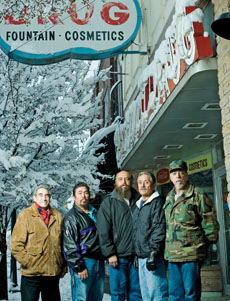 As Jimmy Martinez’s
only sister, Beatrice Martinez Carlson, remembers, she would go to the soda fountain in
Vincent Drug following school. After ordering a 25-cent ice-cream sundae and asking the
soda jerk to pile on the whipped cream, she would ask for some additional hard candy and
then place it all on her father’s account. She’d walk along Main Street past
T-Rays, Christine’s and the Pastime Taverns, past the union hall, Burke’s
Theater, the photography studio and under the barber pole. Shoppers came and went from
J.C. Penney’s, Burns Grocery, Duke’s Clothing and Brown’s Shoes. At the end
of the Avenues was the dusty baseball park where Midvale kids and rivals from West Jordan
gathered for pickup games of baseball and football. She could lick her sundae and munch on
Chick-O-Stix while watching her private and peaceful world go by from the wooden
bleachers.
As Jimmy Martinez’s
only sister, Beatrice Martinez Carlson, remembers, she would go to the soda fountain in
Vincent Drug following school. After ordering a 25-cent ice-cream sundae and asking the
soda jerk to pile on the whipped cream, she would ask for some additional hard candy and
then place it all on her father’s account. She’d walk along Main Street past
T-Rays, Christine’s and the Pastime Taverns, past the union hall, Burke’s
Theater, the photography studio and under the barber pole. Shoppers came and went from
J.C. Penney’s, Burns Grocery, Duke’s Clothing and Brown’s Shoes. At the end
of the Avenues was the dusty baseball park where Midvale kids and rivals from West Jordan
gathered for pickup games of baseball and football. She could lick her sundae and munch on
Chick-O-Stix while watching her private and peaceful world go by from the wooden
bleachers.
Those serene times would slowly—then suddenly—come to an end. Slowly, because shopping malls drew customers elsewhere, and new subdivisions sprouted to the south and west. Suddenly–especially for these three families–because the war in Vietnam would shatter all prospects for an idyllic future forever. The day after the Cintrons’ learned the fate of their oldest son, a knock fell on the door of the Martinez family house on Seventh Avenue. Jimmy Martinez was dead. Days later, death called again, this time at a Sixth Avenue door and bearing the bad news about Tom Gonzales.
The three boys knew each other well. According to a Deseret News story from Nov. 29, 1967, headlined “Buddies Die in Vietnam,” Martinez and Tafoya “double-dated. They worked on their cars together. They hunted and fished together. They buddied around with the same group of youngsters.”
When news filtered through the close-knit community that three of their own had died in Vietnam, Midvale was plunged into mourning. In the local Catholic parish, where the Martinez and Gonzales funerals were held, mourners filled the church and spilled into the nearby neighborhood. An LDS wardhouse in West Jordan also overflowed with mourners paying respects to LeRoy Tafoya. Three times “Taps” rang out across local, crowded graveyards. Three times military honor guards fired salutes into the air.
It seemed like all we were doing was going to funerals,” Tafoya’s mother says. “One funeral after another.”
A KNOCK AT THE DOOR
Listen to Eloy Romero, and you enter his Vietnam. You sense his fear of not knowing who
the enemy really is. You hear the sounds of war, even laughter sometimes, but especially
the rapid bursts from Romero’s M60
machine gun. You hear one of the most distinctive sounds from the Vietnam War, the
whoop-whoop-whoop of Huey helicopters.
LeRoy Tafoya boarded one such Huey on Nov. 22, 1967. A rifleman in Charlie Company, 2nd Battalion, of the 7th Cavalry, 1st Cavalry Division (Airmobile), he and the rest of third platoon were being flown out to support fellow infantry who had been ambushed by a Viet Cong battalion. The second platoon of Delta Company had earlier set out on a routine search-and-destroy mission 20 kilometers north of the fishing town of Phan Thiet, in Binh Thuan province, South Vietnam, when enemy fire pinned them down on the edge of a rice paddy.
That morning, Tafoya wrote to his mother, Donna Cintron, asking her to describe the West Jordan house his family had recently moved to, “so I can picture it in my mind.” In his letter, he mentioned the grueling, nine-month-long strike of 1967 at the Kennecott copper mine which had left so many of their family and friends struggling to get by without wages. He asked her to send “Nelli’s cheli [sic] beans” and a Christmas care package so “I can celebrate. Ha.” About what he called this “dirty war,” he had nothing “new to say.”
As a postscript, he told his mother to give his girlfriend some of the pictures he had taken in Vietnam. He always sent his film for her to develop and keep for his return. He would never see the photos. A few hours after he folded the letter and sealed the envelope, an ensuing act of heroism cost him his life.
How Tafoya died is described in the citation of his posthumous Silver Star award: Tafoya “exposed himself to the enemy fire as he moved forward to provide security for his platoon’s right flank.” He was wounded by an exploding mortar shell. “Despite his wound, [he] remained exposed to enemy fire as he provided covering fire for a helicopter which was trying to land. While providing this suppressive fire [he] was mortally wounded.” Tafoya was 19 years old.
Several days later, two uniformed men knocked on Donna Cintron’s door. They entered, stood at the door and told her that her eldest son had been killed.
“I don’t even believe this,” she said. Her then-13-year-old son Jose Luis (Joe) stood by her side, glaring at the officers, he recalls, because “they had made my mom sad.”
She pleaded that, “I just got a letter from him. I already wrote him three letters.” Every day she wrote to her son. A small pile of her letters was later returned. On Nov. 27, the letter Tafoya wrote the day he was killed arrived at the Cintron home.
Donna Cintron remembers little else. “It’s just hard to explain,” she says, her voice breaking. “It took me more than five years before I could even talk about it. It’s still very hard after 40 years. It seems like yesterday.”
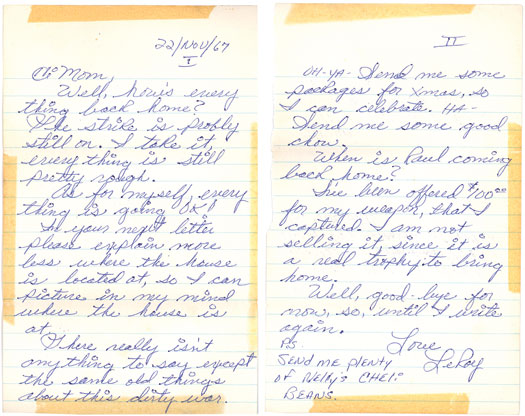
THE MAN WHO LOVED CHILDREN
One of Cintron’s most treasured possessions is a letter she received from Tafoya’s
sergeant, Howard Carney, written five days after her son’s death.
Carney wrote that his letter was not “standard procedure,” but that Tafoya had been so respected by his men, “we felt as though we should write.” He went on, “We all must die, but how a man dies is important. Frank was a man’s man and he gave his life for freedom. He did not die without purpose or accomplishment as a lot of people do.”
Indeed Tafoya had plans for his life after the war. Much like his friend Jimmy Martinez, Tafoya loved children and wanted to help them any way he could. He planned to go to college and, his mother says, “get an education that would help him work with the community and the children. His hope was to have better things for the children in Midvale.”
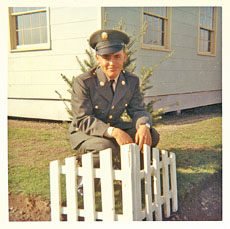 Tafoya
worked at the Midvale Community Action Center to gather local children together and keep
them off the streets. Raul Cintron recalls that his older half-brother LeRoy was
especially protective of his siblings. “He’d put his point across so bullies
wouldn’t bother us anymore,” he says.
Tafoya
worked at the Midvale Community Action Center to gather local children together and keep
them off the streets. Raul Cintron recalls that his older half-brother LeRoy was
especially protective of his siblings. “He’d put his point across so bullies
wouldn’t bother us anymore,” he says.
But Tafoya couldn’t solve the strife at home. The tensions were so strong between him and his stepfather that he enlisted after graduating from Bingham High School in 1966. “He said things would probably be better at home if he wasn’t there,” Donna Cintron says. “I begged him and begged him not to go … but he had already made up his mind.”
“When he left us, it broke my heart,” Raul Cintron says.
From Fort Lewis, Washington, where Tafoya did his basic training, and then in Vietnam, he wrote his mother and family constantly. Sadly, only two letters remain. “I had a whole box of letters and my husband burned them all,” Donna Cintron says, unable to forgive the man she later divorced.
She does have her son's photographs, though. “He wanted to take a lot of pictures so he had a lot of memories when he got home,” she says. “I started this album for him, but he never saw these pictures.”
Children are in many of Tafoya’s Vietnam photos. One smiling little boy wears Tafoya’s helmet and carries his M16. Orphaned by the war, the child “tagged along with LeRoy,” his mother says, polishing his shoes, hanging out with him. Tafoya became attached to the boy. When Tafoya was killed, the boy came looking for him. He asked a soldier where he was. The man told him he had been killed. But the boy’s English was poor. “Who, his brother?” he kept repeating, unable to comprehend. Finally he understood his GI friend LeRoy was dead. The boy broke down and cried.
When the body reached Salt Lake City, Cintron insisted on viewing her son. The military wanted to keep the casket closed. “I told them I’m not going to allow you to bury him unless you open it,” she says. She wanted to know it was her son. “I’m not going to believe it unless I see it,” she said.
It took the military some time to prepare the body. She and several other family members viewed it, then the casket was closed for the service and funeral at Lake Hills Memorial in Sandy. The Martinez and the Gonzales’ families were present.
Raul Cintron didn’t believe his father when he told him his brother was dead. “It hit Raul so bad, so bad,” his mother says. “At the funeral, he threw himself on top of the casket and I felt helpless to comfort him.”
While Tafoya did what his country asked of him, Raul Cintron wonders if he died for a just cause. “The guys who died there died for nothing,” he says. “But it doesn’t take away anything from those guys who went there.”
ROAD TRIP
It should have been the perfect road trip. Jimmy Martinez had a 72-hour leave from San
Diego’s Camp
Pendleton before shipping out for Vietnam. His brothers Eli, George and Norbert
decided to drive him back to camp. But Eli Martinez’s 1965 Pontiac was burning oil,
his brother Norbert recalls with irritation. Their final hours together evolved into an
18-hour marathon of constantly replacing oil. “It screwed our whole time together,”
he says.
They arrived late to Camp Pendleton and Jimmy Martinez ran to get in line with his unit as they prepared to leave for Vietnam. “That was the last time I saw him alive,” Norbert Martinez says.Jimmy Martinez was the fourth of 10 brothers and a sister. His family was the 11th generation of Spaniards who settled the Santa Fe territory in the 1600s. Martinez’s grandfather was a sheep-herder and cattleman who lived in Taos, N.M. in the 1920s. Jimmy's father Andres eventually moved the family to the primarily Mexican-American enclave of Dinkeyville in Copperfield, Bingham Canyon, just one of the “league of nations” communities strung throughout the canyon. They were surrounded by nearly two dozen ethnic groups including Greeks, Italians, Japanese, Slavs and Poles.
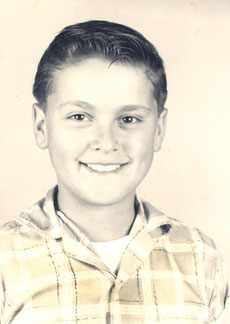 Norbert Martinez remembers the high-pitched whine of the mining shovels, the
shrill whistles that announced blasting, the way the ground shook with each explosion, and
the dust that hung in the air. His memories are of all of the kids playing in the hills,
swimming at the Civic Center, of dodging vehicles on Bingham’s narrow Main Street, of
fistfights and playing ball.
Norbert Martinez remembers the high-pitched whine of the mining shovels, the
shrill whistles that announced blasting, the way the ground shook with each explosion, and
the dust that hung in the air. His memories are of all of the kids playing in the hills,
swimming at the Civic Center, of dodging vehicles on Bingham’s narrow Main Street, of
fistfights and playing ball.
“We used pick handles from the mines instead of bats and wrapped black tape around the balls when they were broken,” he says. The ball field was wherever they made one.
Jimmy Martinez worked as a delivery boy at Kim’s Market in Copperton earning $1.25 an hour. His cousin Gene Martinez helped Jimmy at the store on Saturdays, in exchange for Jimmy buying him a burger at the Copper Queen next door. Gene, too, would serve in Vietnam as an Army transport truck driver. When Gene returned from the war, he went to see his aunt Maria. “I felt guilty,” he says. Although she said nothing, he felt her question hanging in the air—how come he got back OK?
Norbert Martinez’s abiding memory is of his happy-go-lucky brother Jimmy getting off the Hillcrest High School bus. As he walked home, stick in hand rattling the picket fences, he slapped the open hands of awaiting neighbors as they raised them in salute. Jimmy had a girlfriend who lived in Clearfield whom he wanted to marry before enlisting, but Norbert thought it was a bad idea.
“In his mind he thought he was doing the greatest thing,” Norbert Martinez says, “and that he’d come back and pick up his life with her. I talked him out of it.”
BOOBY TRAPPED
David “Doc” Johnson was one of two Navy corpsmen assigned to Lance Cpl. Jimmy
Martinez’s platoon in Hotel Company, 2nd Battalion, 1st Marine Regiment, 1st Marine
Division. His company was known as Hell’s Hotel. Its motto: You check in, but you
don’t always check out.
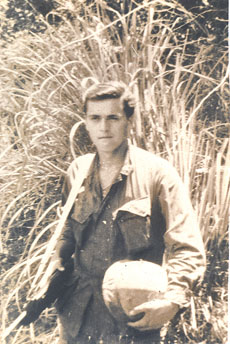 Vietnam quickly proved to be a dangerous place for young Jimmy. During his
tour, Jimmy was wounded and transferred to the hospital ship the USS Repose stationed off the Vietnamese coast.
Recently retired KSL 5 newscaster, Dick Nourse, interviewed Martinez aboard the Repose
in 1967. Jimmy told him how he and three other Marines had been wounded while patrolling
through elephant grass. One of them had triggered an American M26 fragmentation grenade
rigged up by the enemy as a booby trap. Jimmy was
the least wounded of the four. When Nourse asked how he managed to get off so lightly,
Jimmy said, with a broad smile, “I just happened to luck out I guess.”
Vietnam quickly proved to be a dangerous place for young Jimmy. During his
tour, Jimmy was wounded and transferred to the hospital ship the USS Repose stationed off the Vietnamese coast.
Recently retired KSL 5 newscaster, Dick Nourse, interviewed Martinez aboard the Repose
in 1967. Jimmy told him how he and three other Marines had been wounded while patrolling
through elephant grass. One of them had triggered an American M26 fragmentation grenade
rigged up by the enemy as a booby trap. Jimmy was
the least wounded of the four. When Nourse asked how he managed to get off so lightly,
Jimmy said, with a broad smile, “I just happened to luck out I guess.”
That luck ran out on a rainy Thanksgiving Day. Jimmy’s platoon was on a night patrol heading for a predesignated ambush site. They were in the low areas, close to rice paddies and rolling hills. The Marine walking point tripped a wire connected to a 105 mm, unexploded American bomb. This type of booby trap was far more lethal than the grenade-type Jimmy had survived prior. Doc Johnson remembers the huge explosion, “but it was dark as hell in the middle of the night and you couldn’t tell one from another. There wasn’t anything to do but stick them in body bags.” Three Marines had been killed instantly. One of them was Midvale’s Jimmy Martinez. Radio operator Luis Parker heard the explosion from the battalion area. He and Jimmy were friends. “What brought us together was the fact we were both Mexican-Americans,” he says. As a minority, Hispanics clustered together from Day 1 in basic training, Parker recalls. “The drill instructor used to call out ‘Give me all my niggers and spics up here,’” for punishing push-ups. “There was always one with a mean streak.” To a certain degree, he admits, he found a racial divide in the Marine Corps he didn’t care for.
Doc Johnson wasn’t close to Jimmy, partly, he says, because the rifleman and his friends “spoke Spanish, and no one else did. I had a little bit of a problem with that.” He put it down to a communication and lifestyle issue—“people hanging out with their people.”
IS HE ALL THERE?
As Hotel Company radio operator, Luis Parker’s responsibilities included going
through his friend’s personal possessions before they were shipped home. He boxed up
Jimmy’s watch, dogtags, ring, shaving gear and wallet. “I don’t think after
that I really wanted to get close to anyone any more,” he says. The body was shipped
to a DaNang morgue and then on to the family, an escort from the unit accompanying it
home.
After he spent nearly a year in Vietnam, Jimmy's family expected him home for Christmas. Several days after Thanksgiving, his youngest sister, Beatrice, then 9, was bouncing on the couch when she saw several officers walk up to the front door. The family gathered in the living room. One officer read out the black words on the yellow telegram. “Dad fainted. He just dropped,” Beatrice says.
Norbert Martinez collected the body from a hangar at the airport two weeks later. He was determined to make sure his brother’s body was all there. He leaned into the coffin and felt his arms, his torso, his legs. “I had to know,” he says. Jimmy was intact. The concussion of the explosion had broken his neck. He was 20 years old.
A MOTHER’S LOVE
Five years after Jimmy Martinez died, his wartime friend Luis Parker visited the Martinez
family in Midvale. Parker was on a driving tour from California to Florida and stopped in
for coffee. The Martinez hospitality took hold and he attended a family wedding. He stayed
for three days.
He also visited his friend’s grave. But it was the shrine in the family home that took his breath away. In a glass-enclosed cabinet resides Jimmy’s Marine Corps dress blues and his Purple Heart—as well as photographs of Gonzales and Tafoya. Parker lost it. Jimmy’s father Andres put his arms around Parker. “It was the first time I ever openly wept—and here I was in a strange person’s house,” Parker recalls.
The shrine to this fallen family hero—and friends—remains today. Mama Maria, at the age of 88 and with the help of a full-time nurse, still lives on Seventh Avenue, surrounded by dozens of family portraits plus tributes to the Kennedys and John Wayne. Photos of Jimmy as a child, teenager, high school graduate and, finally, as a Marine adorn the walls. Her children say she has never gotten over the loss of her son.
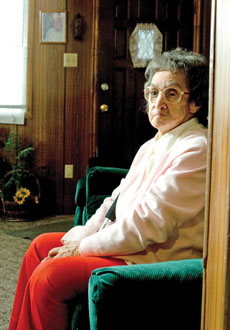 “Mother cried for 20 years,” Norbert Martinez says. His sister
Beatrice says her mother always became emotional on Thanksgiving Day. Only in the last 10
years has she started to enjoy it. “She couldn’t talk about him a whole lot; she’d
cry all the time,” Beatrice says. “It’s the hardest thing, losing a child.”
“Mother cried for 20 years,” Norbert Martinez says. His sister
Beatrice says her mother always became emotional on Thanksgiving Day. Only in the last 10
years has she started to enjoy it. “She couldn’t talk about him a whole lot; she’d
cry all the time,” Beatrice says. “It’s the hardest thing, losing a child.”
Ask Maria Martinez about her son, and she struggles to speak. “He wasn’t with me very long,” she says, dabbing at welling tears with a balled-up handkerchief. She’s a small, thin woman with a rigidly straight back. “They killed him. Muy triste.”
Muy Triste. Very sad.
FNG
On Dec. 7, 1967, squad leader Tom Gonzales was directing his men on a sweep through a
Vietnamese village in Binh Dinh
province. Craters from field artillery and bombs dropped by jets scarred the land
around the bamboo-framed and straw-roofed hooches. The village and surrounding area had
been “prepped.”
Like Jimmy Martinez, Gonzales was “short”—the term used for a soldier nearing completion of his tour. He was counting the days. Like Tafoya, Gonzales was a member of the 1st Cavalry Division (Airmobile). Gonzales’ company had been airlifted to this position to support and extract a reconnaissance unit that was in deep trouble. A pitched battled ensued between Bravo Company and the North Vietnamese Army (NVA) regulars entrenched in nearby hedgerows and hidden tall trees. At 2 p.m. Gonzales and his men of 2nd platoon moved forward in a horizontal line through the hooches.
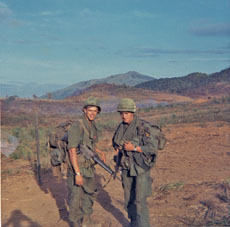 It was pouring rain. Next to Gonzales was Willis Padget, a FNG—a
“Fucking New Guy” as soldiers new to Vietnam were known. Padget had been with
Gonzales’ unit just over a week, and this was his first battle. They didn’t know
each other well, but Padget already had respect for his young sergeant. “He knew what
he was doing and took care of his men well,” he says. Padget stopped to light a
cigarette. Gonzales continued onward. Padget couldn’t get his lighter to work.
Gunfire forced the troops to duck for cover. Gonzales charged forward, squatted down,
pulled the pin from a grenade and prepared to throw it at the enemy. A shot rang out, and
he fell, landing on his grenade. “It killed him instantly,” Padget says. “He
did a very brave thing there.”
It was pouring rain. Next to Gonzales was Willis Padget, a FNG—a
“Fucking New Guy” as soldiers new to Vietnam were known. Padget had been with
Gonzales’ unit just over a week, and this was his first battle. They didn’t know
each other well, but Padget already had respect for his young sergeant. “He knew what
he was doing and took care of his men well,” he says. Padget stopped to light a
cigarette. Gonzales continued onward. Padget couldn’t get his lighter to work.
Gunfire forced the troops to duck for cover. Gonzales charged forward, squatted down,
pulled the pin from a grenade and prepared to throw it at the enemy. A shot rang out, and
he fell, landing on his grenade. “It killed him instantly,” Padget says. “He
did a very brave thing there.”
Padget always tells people smoking saved his life. “It would have been me that got shot if I hadn’t stopped.” Gonzales’ brother Gene, the youngest of the family’s 14 children, puts it slightly differently. “Tom died because some guy smoked,” he says.
Gonzales had been shot by a sniper hiding in a spider hole, one of the many tunnel-fed, camoflagued firing positions that the NVA and Viet Cong fought from. “Someone on the line subdued that guy,” Padget says, a euphemistic way of saying that a particular North Vietnamese soldier’s family would never see their son alive again either.
Padget called for a medic. Al Schroeder, who had arrived in Vietnam in September 1967, ran to see if he could help Gonzales. His job was to keep a wounded soldier alive long enough to get him out of the field to a medical facility. “One of the things I struggled with over the years was not being well prepared,” Schroeder says.
He tried to revive Gonzales. Another medic scrambled up to Schroeder. “Let him go,” he told him. “He’s dead.” He was 20 years old.
RUNNING HOME
In that same battle, a Bravo Company platoon leader had been killed. By mid-December three
more members of Gonzales’ platoon had died, blown up in their foxhole by a stray
shell fired by American artillery. “The lights went out,” Schroeder says,
adding, “From then on, no feeling. It was overtly a survival game, covertly a
protect-your-sanity game.”
In 1993, at a battalion reunion dinner, the mental storage unit in which medic Schroeder had locked away the death of Gonzales and the four other Bravo Company men started to open. His quest began. He came to Utah in summer 2001 and was met by Tom Gonzales’ brother Mike at the airport. He and Schroeder visited the Bingham Canyon Mine where Tom's father had worked for 38 years. In 1956, the Gonzales family moved from Dinkeyville to Midvale. “We grew up in the Midvale ballpark,” Gene Gonzales says.
Like every other Bingham boy, Tom Gonzales gathered bits of shiny ore found everywhere and sold them to tourists. A hero to his younger brothers, he vigilantly protected Louie and Gene from bullies. Gonzales had a knack for cars and worked at a Phillips 66 station on State Street and later at Gordon Wilson Chevrolet. His prized possession was a 1956 green Ford, a gift from his older brothers. The Gonzales family still tends to that truck.
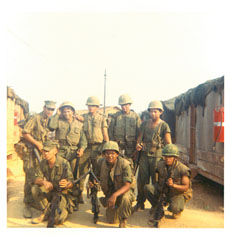 Tom Gonzales was the
fifth of the boys in his family to join the military. Their oldest brother David (Doogie)
fought in Korea. These are people familiar with military ways. But, meeting Schroeder,
whose vain attempts could not keep their brother alive, was a complicated encounter for
the Gonzales family. Because the trip was Schroeder’s way of processing his own past
rather than helping the people he visited, he “wasn’t prepared for the notion
the families needed help.” He recalls them as “cordial.”
Tom Gonzales was the
fifth of the boys in his family to join the military. Their oldest brother David (Doogie)
fought in Korea. These are people familiar with military ways. But, meeting Schroeder,
whose vain attempts could not keep their brother alive, was a complicated encounter for
the Gonzales family. Because the trip was Schroeder’s way of processing his own past
rather than helping the people he visited, he “wasn’t prepared for the notion
the families needed help.” He recalls them as “cordial.”
One of the realities of the Vietnam War, Schroeder says, is that “when we came home, not only were we not respected or acknowledged, we were shunned and degraded. People had always closed themselves off to veterans.” What he didn’t realize was that surviving families had closed themselves off to their own pain, too. He was floored, he says, that they hadn’t moved forward.
That pain reveals itself in the eyes of Gene Gonzales as he recalls a 40 year old memory. He was in class when the school office summoned him and sent him home. The Gonzales family expected Tom home soon, their mother most anxiously of all. Gene falls silent and points to his throat. He can’t speak. He goes away and gets a drink of water. “I thought when I left school, Tom had come home,” he continues, recalling his premature optimism on that cold December day. He stops again. “Give me a minute,” he says. He disappears into his bedroom to compose himself. In the painful silence he leaves behind, the image of a teenager running home to fling his arms around his adored older brother is indelible.
Tom Gonzales is buried next to his parents. Gene visits the grave twice a year on Memorial Day and Christmas. “I try not to think about it,” he says about the loss of his brother. “I feel like my feelings for my brother are in my heart.”
ONE
MORE PICKUP GAME
Vietnam Army veteran Tim O’Brien’s
Pulitzer-finalist novel The
Things They Carried artfully weaves the eyewitness Vietnam-veteran experience
with the nuanced truths wrought of those experiences through a connected series of moving
short stories. The stories of LeRoy Tafoya, Jimmy Martinez and Tom Gonzales are no less
moving and equally prey to nuanced truths over the passage of time. Fact and fiction blur.
As Tafoya’s half-brother Raul Citron says about trying to remember childhood events,
“It’s kind of muffled in my head.”
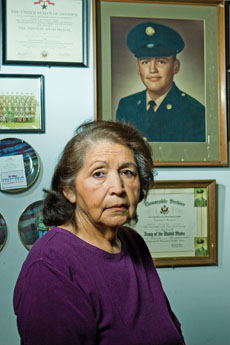 Donna Cintron’s choking sentences, Maria Martinez’s misty tears and
the inability of Gene Gonzales to speak evoke far more than any brittle words or
half-remembered war stories might betray. They reveal truths that the telling of stories
cannot.
Donna Cintron’s choking sentences, Maria Martinez’s misty tears and
the inability of Gene Gonzales to speak evoke far more than any brittle words or
half-remembered war stories might betray. They reveal truths that the telling of stories
cannot.
The soldiers in O’Brien’s book carried weapons and keepsakes that reminded them of who they were. These relatives carry no more than photographs and memories. That’s all they have to remind them not only of their loss but also of who they are as survivors.
For George Martinez the loss of his brother Jimmy came full circle when his son, Johnny James Martinez, returned from Iraq. “Sometimes I see Johnny on the stairs,” he says, “and I tell my wife, ‘I just seen John walk downstairs’ ... and it was Jimmy.” He sees his brother, yet he doesn’t.
Midvale fenced off the baseball diamond at the bottom of the Avenues where LeRoy, Jimmy and Tom all played ball, and where each imagined himself to be Mantle or Mays or Snyder. When George Martinez first saw the locked chain-link fence, he felt like he’d been struck in the chest. The wooden bleachers were replaced by metal ones and the pickup games are no more.
But perhaps there could be one more game.
Imagine sitting in those bleachers 40 years ago. A noisy game is being played on the dusty field before you, boys scrambling in cutoffs and T-shirts, yet your eyes wander. To your left, to the east, your eyes settle on the comfortable houses of the Midvale Avenues. Above those homes rise the Wasatch Mountains. Now your gaze moves to the right, westward, as the setting sun falls over the Oquirrh Mountains. You catch a coppery glint and the Bingham Canyon Mine reveals itself.
Centered midvalley, placed perfectly between the high mountain rims on either side and as if at the bottom of a birds nest lies Midvale. Beyond the shelter of this safe cradle, farther beyond the mountains than you have ever been is the mysterious Vietnam. On the field below, the baseball game is nearing its end in the dimming light. The crowd awaits, hoping. The bases are loaded. Tommy’s on first, LeRoy’s on second and Jimmy’s on third. All each of them needs is one more hit to bring them safely home.
Bingham Canyon native and
City Weekly founder John Saltas contributed to this story.Read John Saltas' Sidebar: Dinkeyville
Read Private Eye: Kids With Guns